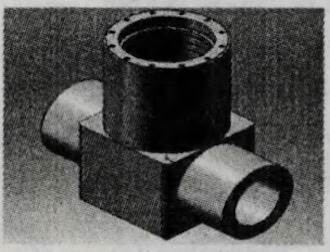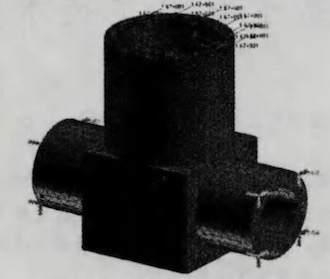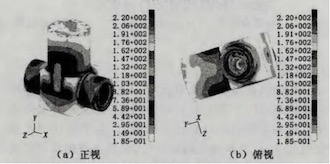Analysis of Strength of Finite Element Model of Valve Bodies
Analysis of Strength of Finite Element Model of Valve Bodies
Mar 08, 2023
Aiming at the high-risk working conditions of the hydrogenation valve, the overall forging structure of the valve body is designed. Aiming at the complexity of the influence of valve body materials, runner forms, and integral forging structure on valve body’s quality. The finite element analysis software Patran is used for strength analysis, and the stress and deformation of the valve body in all directions under the maximum working condition are obtained, which verifies the rationality of the structural design of the valve body parts, and provides a method for the structural design of the special valve body, providing a basis for the follow-up optimization design work.
Analysis of strength of finite element model of valve bodies
2.1 Known conditions
The hydrogenation valve body is made from ASTM A105N. The yield strength of the material is greater than and equal to 250MPa, and the yield strength in the material report of the qualified supplier is 360MPa. The tensile strength is greater than and equal to 485MPa; the elastic modulus is 202GPa, and the Poisson’s ratio is 0.30. The internal pressure of the valve is 25MPa.
2.2 Boundary conditions
(1) The pipe size of the channel two-port is 219.1 mm X 174.5 mm
(2) The A-A self-sealing part is subjected to 25MPa internal pressure and the radial component force is 221.6kN generated by the self-sealing of the bonnet. The specific pressure of the self-tightening sealing ring to the valve body is 102.7MPa, and the bonnet is well connected to the mesh body. After that, it can be used as an intermediate rigid plate.
(3) Tr270×6 trapezoidal threaded surface bears a medium pressure of 1276.8kN.
(4) The 5/8-11UNC thread bears a force of 299.8kN when the wedge is closed.
(5) The center of the intersection of the middle cavity of the valve body and the channel is subjected to a sealing force of 402.6kN by the wedge and the mesh seat along the axis of the channel.
2.3 The analysis of structural strength
2.3.1 Establishment of mesh finite element models
The hydrogenation valve body part has a forging structure with a round hole, and there are transition fillets and chamfers at each connection. Its structure is relatively complicated, so the model should be simplified when solid modeling. According to St. Venant's principle 1, some partial features of the valve body, such as chamfered (round) corners and screw holes were appropriately simplified. After the simplification, a three-dimensional model of the valve body was established by using SolidWorks, as shown in Figure 2.

Figure 2 Three-dimensional model of the valve body
2.3.2 Grid division
The TetMesh grid generator in Patran is used, and the density of the grid is controlled by the Global Edge Length method, and the nodes and units are divided by 10-node tetrahedral elements to complete the division of the valve body grid.
2.3.3 Constraints of loading displacement and pressure
According to the requirements of the boundary conditions, the loading of the boundary conditions of the valve body is completed under the MSC. Patran Loads/BCs module, and the setting of the elastic modulus and Poisson's ratio of the valve body material are completed under the Materials and Proper modules. The finite element model after loading is shown in Figure 3.
2.3.4 Solutions
Under the Analysis module, the Nastran solver is called for a linear solution, and the stress cloud map of the mesh body can be obtained, as shown in Figure 4.

Figure 3 The finite element model of the mesh body

(a) Facing up (b) Looking down
Figure 4 Stress cloud diagram of the valve body
3. Results Analysis
From Figure 4, it can be found that under load, the maximum stress generated by the part is 220MPa, which is lower than the yield limit of the material of 250MPa, and lower than the yield strength of 360MPa in the material report of the qualified supplier. The safety factor reaches 1.6; it can also be seen from Figure 4 that most of the stress is below 118MPa, and only a partial stress concentration occurs at the junction of the valve body cavity and the channel, but it is lower than the material's yield limit of 250MPa. From the above analysis results, it can be concluded that the structure of the part is reasonable; the selected material is reliable, and can withstand the load during work.
4. Conclusion
(1) The structural design of the hydrogenation valve based on finite element technology provides a method for the localization of the forged steel hydrogenation valve at the present stage, and provides a way for the promotion of multi-directional die technology in China.
(2) Through finite element analysis, it can be seen that the maximum stress generated by the valve body parts during operation is 220MPa, which is lower than the yield limit of the material 250MPa, lower than the yield strength of 360MPa in the material report of the qualified supplier, and can withstand high-pressure loads. Meet the requirement for strength under high-risk conditions.
(3) In view of the complexity of the influence of mesh materials, flow channel forms, and overall forging structure on the quality of the valve body, finite element technology was introduced in the structural design process of the hydrogenation mesh valve body, which is suitable for high temperature, high pressure and other harsh environmental conditions. The product structure design not only provides a method, but also a basis for the follow-up optimization design work.
Analysis of strength of finite element model of valve bodies
2.1 Known conditions
The hydrogenation valve body is made from ASTM A105N. The yield strength of the material is greater than and equal to 250MPa, and the yield strength in the material report of the qualified supplier is 360MPa. The tensile strength is greater than and equal to 485MPa; the elastic modulus is 202GPa, and the Poisson’s ratio is 0.30. The internal pressure of the valve is 25MPa.
2.2 Boundary conditions
(1) The pipe size of the channel two-port is 219.1 mm X 174.5 mm
(2) The A-A self-sealing part is subjected to 25MPa internal pressure and the radial component force is 221.6kN generated by the self-sealing of the bonnet. The specific pressure of the self-tightening sealing ring to the valve body is 102.7MPa, and the bonnet is well connected to the mesh body. After that, it can be used as an intermediate rigid plate.
(3) Tr270×6 trapezoidal threaded surface bears a medium pressure of 1276.8kN.
(4) The 5/8-11UNC thread bears a force of 299.8kN when the wedge is closed.
(5) The center of the intersection of the middle cavity of the valve body and the channel is subjected to a sealing force of 402.6kN by the wedge and the mesh seat along the axis of the channel.
2.3 The analysis of structural strength
2.3.1 Establishment of mesh finite element models
The hydrogenation valve body part has a forging structure with a round hole, and there are transition fillets and chamfers at each connection. Its structure is relatively complicated, so the model should be simplified when solid modeling. According to St. Venant's principle 1, some partial features of the valve body, such as chamfered (round) corners and screw holes were appropriately simplified. After the simplification, a three-dimensional model of the valve body was established by using SolidWorks, as shown in Figure 2.

Figure 2 Three-dimensional model of the valve body
2.3.2 Grid division
The TetMesh grid generator in Patran is used, and the density of the grid is controlled by the Global Edge Length method, and the nodes and units are divided by 10-node tetrahedral elements to complete the division of the valve body grid.
2.3.3 Constraints of loading displacement and pressure
According to the requirements of the boundary conditions, the loading of the boundary conditions of the valve body is completed under the MSC. Patran Loads/BCs module, and the setting of the elastic modulus and Poisson's ratio of the valve body material are completed under the Materials and Proper modules. The finite element model after loading is shown in Figure 3.
2.3.4 Solutions
Under the Analysis module, the Nastran solver is called for a linear solution, and the stress cloud map of the mesh body can be obtained, as shown in Figure 4.

Figure 3 The finite element model of the mesh body

(a) Facing up (b) Looking down
Figure 4 Stress cloud diagram of the valve body
3. Results Analysis
From Figure 4, it can be found that under load, the maximum stress generated by the part is 220MPa, which is lower than the yield limit of the material of 250MPa, and lower than the yield strength of 360MPa in the material report of the qualified supplier. The safety factor reaches 1.6; it can also be seen from Figure 4 that most of the stress is below 118MPa, and only a partial stress concentration occurs at the junction of the valve body cavity and the channel, but it is lower than the material's yield limit of 250MPa. From the above analysis results, it can be concluded that the structure of the part is reasonable; the selected material is reliable, and can withstand the load during work.
4. Conclusion
(1) The structural design of the hydrogenation valve based on finite element technology provides a method for the localization of the forged steel hydrogenation valve at the present stage, and provides a way for the promotion of multi-directional die technology in China.
(2) Through finite element analysis, it can be seen that the maximum stress generated by the valve body parts during operation is 220MPa, which is lower than the yield limit of the material 250MPa, lower than the yield strength of 360MPa in the material report of the qualified supplier, and can withstand high-pressure loads. Meet the requirement for strength under high-risk conditions.
(3) In view of the complexity of the influence of mesh materials, flow channel forms, and overall forging structure on the quality of the valve body, finite element technology was introduced in the structural design process of the hydrogenation mesh valve body, which is suitable for high temperature, high pressure and other harsh environmental conditions. The product structure design not only provides a method, but also a basis for the follow-up optimization design work.
Next: Forged Stainless Steel Valves
Previous: Structural Design of Hydrogenation Valve Bodies
News
About Us
Best Categories
Useful Links